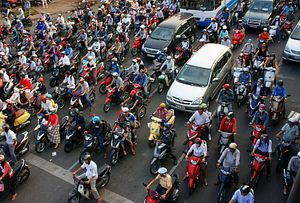In a rapidly growing city like Hanoi, with very little in the way of public transportation, the motorbike plays an important role in keeping traffic flowing. Compared with shiny new cars though, the motorbike is increasingly seen as old-fashioned, dirty and dangerous, and the streets of Hanoi seem destined to become a nightmare of traffic jams.
Of course, some would say that Hanoi is already a traffic nightmare. Anyone who has traveled to the Vietnamese capital knows that the seemingly chaotic sea of motorbikes can be quite a challenge, particularly if you try making your way around town on foot. Yet despite its many perils, mobility in Hanoi is actually quite good, given that it is one of the most densely populated cities in the world. That traffic moves to the extent it does is largely thanks to the use of motorbikes instead of cars. Nonetheless, it is the motorbike that is maligned, by both the government and the public.
The number of motorbikes in Vietnam has grown at an astonishing pace, driven by the country’s economic growth. According to official statistics, there were about 4 million motorbikes in all of Vietnam in 1996; today, there are about that many in Hanoi alone. There are currently around 39 million motorbikes nationwide, meaning that if we exclude the very old and the very young, practically every Vietnamese owns a motorbike.
But there is a new challenger in town. Despite measures from the government in the form of very high taxes and various fees, private car ownership is on the rise. With its promise of status, comfort and safety, owning a car has emerged as the dream of the average Hanoian. A car allows you to stay cool (and pale) in the scorching sun, dry in the heavy rain, and clean from the ever-present dust and pollution. And it is an obvious symbol of success in the new economy. This is promising to be a massive challenge for a city designed around bicycles and motorbikes, with the World Bank estimating that if the trend towards private car ownership continues, traffic in Hanoi will quite simply stop.
Interestingly, Hanoi’s Trade and Industry Department last year made a call for people to start riding bicycles again, sparking debate about the traffic situation in the capital. Many directly opposed the proposal, seeing the old bike as a dangerous obstruction to traffic.
Not many years ago, Hanoi was famous for its many bicycles. After the motorbike revolution, however, only the poorest continued to use bicycles as their main means of transportation. Recently, however, cycling has also seen a revival in popularity as a means of exercise for the middle class, who can often seen riding around West Lake on mountain bikes that are more expensive than motorbikes.
The bicycle has another obvious advantage: it is environmentally friendly. Hanoi is a heavily polluted city. While a car offers escape from the toxic air – even as it helps to make it worse – the majority of people enjoy no such protection. The motorbike is surely no saint either, but a transition to cars will make the situation much worse since emission levels dramatically increase in traffic jams.
It is naïve to think it is possible to keep the car completely at bay. But Vietnam has always, at least rhetorically, promoted alternative development paths. Perhaps the relative chaos of two-wheeled traffic is preferable to the nightmarish gridlocks of the likes of Bangkok and Jakarta.
If Hanoi is to avoid total gridlock, the bicycle will almost certainly need to be part of the solution. Ambitious public transportation plans are still far into the future, and will at any rate meet only about 20 percent of total transport needs in the capital. Making Hanoi more livable again will require some serious policymaking. Contemporary Hanoi is extremely unfriendly to cyclists and pedestrians, and the few bicycle lanes that exist are frequently used as parking sites for cars.
Could Hanoi see a new bicycle revolution? Or could Vietnam rather revolutionize the market by promoting greener motorbikes ? Only time will tell. For now, locals don their face masks, shift gear, and hold their breaths while trying not to be hit by a brand-new BMW.
Arve Hansen is a Research Fellow at the Centre for Development and the Environment, University of Oslo.
































